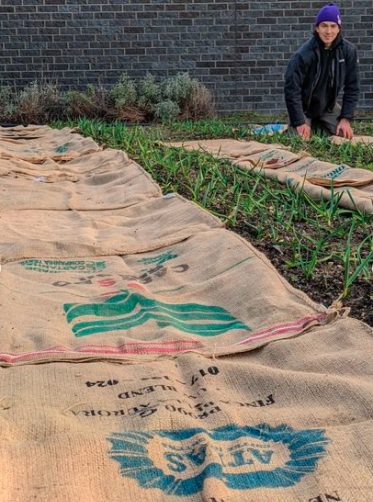UW Farm Weekly Dirt: Eliminating Weeds Without Chemicals
Around the Farm
by Kove Janeski, Graduate Student in Landscape Architecture, UW Farm Student Staff, Operations Lead
 Despite the cold snap we have been experiencing in Seattle, the UW Farm is hard at work preparing and planting our first crops across the Farm’s three campus locations.
Despite the cold snap we have been experiencing in Seattle, the UW Farm is hard at work preparing and planting our first crops across the Farm’s three campus locations.
As the first step in the bed preparation process, we try to remove weeds before planting seeds or transplants. To minimize disturbance of the soil and eliminate the need for chemicals and reduces tilling, which can have a negative impact on the farm ecosystem. We remove the weeds and incorporate the cover crop using large black plastic tarps. Also referred to as Silage tarps (see the UW Farm video), this cost-effective weed management tool, utilizes black, UV-treated polyethylene sheets that block out sun and create warm, moist environments on the surface of the soil. Weeds are starved of sunlight and weed seeds that are encouraged by the warmer temperatures to germinate are also killed. This is a popular practice among small-scale farmers.
For this process to occur in the winter and early spring, we keep silage tarps on beds for 6-8 weeks before planting the bed’s first crops. In summer months we use clear plastic to kill weeds using solarization.
 In other areas, like Mercer Court’s perennial blueberry plots, we use decomposable materials like cardboard and burlap to achieve a similar affect: layers of cardboard, weighted down with wood chips generated on campus, create a dark environment and barrier on top of weeds. However, the cardboard allows for water infiltration for blueberry roots and decomposes over time. The cardboard and chips, as they break down, will also feed the soil around the blueberries, which prefer an acidic environment and do not need nitrogen in large quantities. An alternative to cardboard are other waste products such as coffee bean bags (pictured above between beds of garlic) or pieces of untreated wood.* These can be lifted and moved or remain in place if used in walk-ways.
In other areas, like Mercer Court’s perennial blueberry plots, we use decomposable materials like cardboard and burlap to achieve a similar affect: layers of cardboard, weighted down with wood chips generated on campus, create a dark environment and barrier on top of weeds. However, the cardboard allows for water infiltration for blueberry roots and decomposes over time. The cardboard and chips, as they break down, will also feed the soil around the blueberries, which prefer an acidic environment and do not need nitrogen in large quantities. An alternative to cardboard are other waste products such as coffee bean bags (pictured above between beds of garlic) or pieces of untreated wood.* These can be lifted and moved or remain in place if used in walk-ways.
Placing cardboard around bushes and other hard-to-weed areas with mulch can be an excellent, cost-effective weed reducing method. Replacing the mulch used on top of the cardboard with compost or soil can also be a way to quickly create planting beds while adding nutrients.
*Remember to remove plastic tape, staples and labels when using cardboard and avoid using pressure-treated, painted, or stained wood as these materials can contaminate soil.